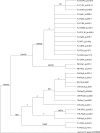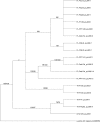Diversity and plasticity of the intracellular plant pathogen and insect symbiont "Candidatus Liberibacter asiaticus" as revealed by hypervariable prophage genes with intragenic tandem repeats
- PMID: 21784907
- PMCID: PMC3187138
- DOI: 10.1128/AEM.05111-11
Diversity and plasticity of the intracellular plant pathogen and insect symbiont "Candidatus Liberibacter asiaticus" as revealed by hypervariable prophage genes with intragenic tandem repeats
Abstract
"Candidatus Liberibacter asiaticus" is a psyllid-transmitted, phloem-limited alphaproteobacterium and the most prevalent species of "Ca. Liberibacter" associated with a devastating worldwide citrus disease known as huanglongbing (HLB). Two related and hypervariable genes (hyv(I) and hyv(II)) were identified in the prophage regions of the Psy62 "Ca. Liberibacter asiaticus" genome. Sequence analyses of the hyv(I) and hyv(II) genes in 35 "Ca. Liberibacter asiaticus" DNA isolates collected globally revealed that the hyv(I) gene contains up to 12 nearly identical tandem repeats (NITRs, 132 bp) and 4 partial repeats, while hyv(II) contains up to 2 NITRs and 4 partial repeats and shares homology with hyv(I). Frequent deletions or insertions of these repeats within the hyv(I) and hyv(II) genes were observed, none of which disrupted the open reading frames. Sequence conservation within the individual repeats but an extensive variation in repeat numbers, rearrangement, and the sequences flanking the repeat region indicate the diversity and plasticity of "Ca. Liberibacter asiaticus" bacterial populations in the world. These differences were found not only in samples of distinct geographical origins but also in samples from a single origin and even from a single "Ca. Liberibacter asiaticus"-infected sample. This is the first evidence of different "Ca. Liberibacter asiaticus" populations coexisting in a single HLB-affected sample. The Florida "Ca. Liberibacter asiaticus" isolates contain both hyv(I) and hyv(II), while all other global "Ca. Liberibacter asiaticus" isolates contain either one or the other. Interclade assignments of the putative Hyv(I) and Hyv(II) proteins from Florida isolates with other global isolates in phylogenetic trees imply multiple "Ca. Liberibacter asiaticus" populations in the world and a multisource introduction of the "Ca. Liberibacter asiaticus" bacterium into Florida.
Figures




Similar articles
-
Improved real-time PCR detection of 'Candidatus Liberibacter asiaticus' from citrus and psyllid hosts by targeting the intragenic tandem-repeats of its prophage genes.Mol Cell Probes. 2012 Apr;26(2):90-8. doi: 10.1016/j.mcp.2011.12.001. Epub 2012 Jan 8. Mol Cell Probes. 2012. PMID: 22245034
-
Multilocus microsatellite analysis of 'Candidatus Liberibacter asiaticus' associated with citrus Huanglongbing worldwide.BMC Microbiol. 2012 Mar 20;12:39. doi: 10.1186/1471-2180-12-39. BMC Microbiol. 2012. PMID: 22433492 Free PMC article.
-
'Ca. Liberibacter asiaticus' carries an excision plasmid prophage and a chromosomally integrated prophage that becomes lytic in plant infections.Mol Plant Microbe Interact. 2011 Apr;24(4):458-68. doi: 10.1094/MPMI-11-10-0256. Mol Plant Microbe Interact. 2011. PMID: 21190436
-
Progress and Obstacles in Culturing 'Candidatus Liberibacter asiaticus', the Bacterium Associated with Huanglongbing.Phytopathology. 2019 Jul;109(7):1092-1101. doi: 10.1094/PHYTO-02-19-0051-RVW. Epub 2019 Jun 3. Phytopathology. 2019. PMID: 30998129 Review.
-
Citrus huanglongbing: a newly relevant disease presents unprecedented challenges.Phytopathology. 2013 Jul;103(7):652-65. doi: 10.1094/PHYTO-12-12-0331-RVW. Phytopathology. 2013. PMID: 23441969 Review.
Cited by
-
Effective antibiotics against 'Candidatus Liberibacter asiaticus' in HLB-affected citrus plants identified via the graft-based evaluation.PLoS One. 2014 Nov 5;9(11):e111032. doi: 10.1371/journal.pone.0111032. eCollection 2014. PLoS One. 2014. PMID: 25372135 Free PMC article.
-
Differential expression of "Candidatus Liberibacter solanacearum" genes and prophage loci in different life stages of potato psyllid.Sci Rep. 2024 Jul 15;14(1):16248. doi: 10.1038/s41598-024-65156-4. Sci Rep. 2024. PMID: 39009624 Free PMC article.
-
Characterization of "Candidatus Liberibacter asiaticus" populations by double-locus analyses.Curr Microbiol. 2014 Oct;69(4):554-60. doi: 10.1007/s00284-014-0621-9. Epub 2014 Jun 10. Curr Microbiol. 2014. PMID: 24912994
-
Molecular mechanisms underlying heat or tetracycline treatments for citrus HLB control.Hortic Res. 2018 Jun 1;5:30. doi: 10.1038/s41438-018-0038-x. eCollection 2018. Hortic Res. 2018. PMID: 29872535 Free PMC article.
-
'Candidatus Liberibacter asiaticus', Causal Agent of Citrus Huanglongbing, Is Reduced by Treatment with Brassinosteroids.PLoS One. 2016 Jan 5;11(1):e0146223. doi: 10.1371/journal.pone.0146223. eCollection 2016. PLoS One. 2016. PMID: 26731660 Free PMC article.
References
Publication types
MeSH terms
Associated data
- Actions
- Actions
- Actions
- Actions
- Actions
- Actions
- Actions
- Actions
- Actions
- Actions
- Actions
- Actions
- Actions
- Actions
- Actions
- Actions
- Actions
- Actions
- Actions
- Actions
- Actions
- Actions
- Actions
- Actions
- Actions
- Actions
- Actions
- Actions
- Actions
- Actions
- Actions
- Actions
- Actions
- Actions
- Actions
- Actions
- Actions
- Actions
- Actions
- Actions
- Actions
- Actions
- Actions
- Actions
- Actions
LinkOut - more resources
Full Text Sources
Other Literature Sources
Molecular Biology Databases

